Coracobrachialis muscle
Table of Contents
Description
The coracobrachialis muscle is a small muscle located in the upper medial part of the arm. It originates from the coracoid process of the scapula (shoulder blade) and inserts into the middle of the humerus bone (upper arm bone).
- The primary function of the coracobrachialis muscle is to assist in the flexion and adduction of the arm at the shoulder joint.
- This means that it helps to bring the arm toward the body’s midline while also bending the elbow.
- The muscle also helps to stabilize the shoulder joint during arm movements.
- The coracobrachialis muscle is innervated by the musculocutaneous nerve, which is a branch of the brachial plexus.
- While the coracobrachialis is a relatively small muscle, it can be important for athletes or individuals involved in activities that require repetitive arm movements, such as throwing a ball or swinging a racket.
- Strengthening exercises that target the coracobrachialis muscle can help to improve arm function and prevent injury.
Structure of coracobrachialis muscle
- The coracobrachialis muscle is covered by the deltoid muscle, which is the large, triangular muscle that covers the shoulder joint.
- The muscle belly of the coracobrachialis is located in the anterior (front) compartment of the arm, which also contains the biceps brachii and brachialis muscles.
- The coracobrachialis muscle is supplied by the musculocutaneous nerve, which is a branch of the brachial plexus.
- This nerve provides both sensory and motor innervation to the muscle.
- The structure of the coracobrachialis muscle allows it to assist in flexing and adducting the arm, as well as stabilizing the shoulder joint during arm movements.
- While it is a relatively small muscle, it plays an important role in upper extremity function.
Origin of the coracobrachialis muscle
- The coracobrachialis muscle originates from the coracoid process of the scapula, which is a bony protrusion on the front of the shoulder blade.
Insertion coracobrachialis muscle
- The muscle inserts into the middle of the humerus bone, which is the bone that runs from the shoulder to the elbow.
Nerve supply of coracobrachialis muscle
- The coracobrachialis muscle is innervated by the musculocutaneous nerve, which is a branch of the brachial plexus.
Arterial supply of coracobrachialis muscle
- The arterial blood supply to the coracobrachialis muscle comes from the brachial artery and its branches.
The function of the coracobrachialis muscle
- The primary function of the coracobrachialis muscle is to assist in the flexion and adduction of the arm at the shoulder joint.
- This means that it helps to bring the arm toward the body’s midline while also bending the elbow.
- The muscle also helps to stabilize the shoulder joint during arm movements.
- In addition, it may contribute to the rotation of the arm inward (medial rotation).
- Overall, the coracobrachialis muscle is considered a minor muscle in terms of its contribution to arm movement, but it can be important for athletes or individuals involved in activities that require repetitive arm movements, such as throwing a ball or swinging a racket.
- Strengthening exercises that target the coracobrachialis muscle can help to improve arm function and prevent injury.
Associated condition of the coracobrachialis muscle
- The coracobrachialis muscle is not commonly associated with specific conditions or injuries, as it is a relatively small and less frequently involved muscle.
- However, it can be affected in certain cases of shoulder or upper arm injuries.
- Injuries to the coracobrachialis muscle may result from repetitive overhead arm movements, such as those performed by athletes involved in throwing or racket sports.
- Overuse or strain of the muscle can cause pain and weakness in the upper arm.
- In rare cases, the coracobrachialis muscle may be affected by nerve injuries, such as damage to the musculocutaneous nerve that innervates the muscle.
- This can cause weakness or paralysis of the muscle and may require medical intervention.
- In general, treatment for injuries to the coracobrachialis muscle involves rest, ice, and physical therapy to help strengthen and rehabilitate the muscle.
- In more severe cases, medical intervention such as surgical repair may be necessary.
Diagnosis
A coracobrachialis muscle injury can be diagnosed through a combination of physical examination, medical history, and imaging tests. Here are some steps that may be involved in diagnosing a coracobrachialis muscle injury:
Physical examination:
- A healthcare professional will examine the affected arm and shoulder to check for signs of injury, such as swelling, bruising, or tenderness.
- They may also assess the range of motion and strength of the arm and shoulder.
Medical history:
- The healthcare professional may ask about your symptoms, when they started, and how they have progressed.
- They may also ask about any recent injuries, medical conditions, or activities that could have caused the injury.
Imaging tests:
- In some cases, imaging tests such as X-rays, ultrasound, or MRI may be used to help diagnose a coracobrachialis muscle injury.
- These tests can help to visualize the muscles, bones, and soft tissues in the affected area and identify any abnormalities or damage.
Based on the results of the physical examination and imaging tests, the healthcare professional may be able to diagnose a coracobrachialis muscle injury and recommend the appropriate treatment. In some cases, further testing or consultation with a specialist may be necessary to confirm the diagnosis or develop a treatment plan.
Differential diagnosis
When evaluating a patient with upper arm or shoulder pain, a healthcare professional will consider a range of possible diagnoses to determine the underlying cause of the symptoms. Some possible differential diagnoses for a coracobrachialis muscle injury include:
Rotator cuff injury:
- A rotator cuff is a group of muscles and tendons that help to stabilize the shoulder joint. Injuries to the rotator cuff can cause pain, weakness, and a limited range of motion in the shoulder.
Biceps tendonitis:
- Inflammation or irritation of the biceps tendon can cause pain and weakness in the upper arm, particularly during movements that involve bending or lifting the arm.
Impingement syndrome:
- Impingement occurs when the tendons or bursae in the shoulder become compressed or pinched, causing pain and a limited range of motion.
Brachial plexus injury:
- The brachial plexus is a network of nerves that control movement and sensation in the arm and hand.
- Injuries to the brachial plexus can cause pain, weakness, or numbness in the upper arm or shoulder.
Fractured or dislocated shoulder:
- Trauma or injury to the shoulder joint can cause fractures or dislocations that result in pain, swelling, and limited mobility.
Frozen shoulder:
- Also known as adhesive capsulitis, frozen shoulder is a condition that causes pain and stiffness in the shoulder joint, often as a result of injury or prolonged immobilization.
Cervical radiculopathy:
- Compression or irritation of the nerves in the cervical spine can cause pain, weakness, or numbness that radiates down the arm and into the shoulder.
To determine the correct diagnosis, a healthcare professional will conduct a thorough physical examination, review the patient’s medical history, and may order additional imaging tests such as X-rays or MRI to visualize the affected area.
Medical treatment of coracobrachialis muscle
In most cases, injuries to the coracobrachialis muscle can be treated conservatively with rest, ice, compression, and elevation (RICE). This can help to reduce pain and inflammation and allow the muscle to heal.
Physical therapy may also be recommended to help restore strength and flexibility to the muscle. This may include exercises to strengthen the coracobrachialis and other muscles in the shoulder and arm, as well as stretching and range of motion exercises.
In some cases, more aggressive medical treatment may be necessary. This can include:
Corticosteroid injections:
- Injections of corticosteroids may be used to reduce inflammation and pain in the affected area.
Surgery:
- In rare cases, surgical intervention may be necessary to repair a torn or damaged coracobrachialis muscle.
- This is usually only considered when conservative treatments have failed to provide relief.
Nerve intervention:
- If the coracobrachialis muscle is affected by nerve injury or compression, nerve intervention such as nerve blocks or surgical decompression may be necessary.
It is important to note that the most appropriate treatment approach will depend on the severity and underlying cause of the coracobrachialis injury. Always consult with a healthcare professional for an accurate diagnosis and appropriate treatment recommendations.
Physiotherapy exercise
Here are some exercises that can help to strengthen the coracobrachialis muscle:
Coracobrachialis curls:
- This exercise involves flexing the arm at the shoulder joint while keeping the elbow close to the body.
- To perform the exercise, you can start with a standing position with your feet shoulder-width apart and hold a dumbbell in one hand.
- Bring the weight up towards your shoulder by flexing your arm at the shoulder joint, keeping your elbow close to your body.
- Slowly lower the weight back down to the starting position and repeat for 8-10 repetitions before switching arms.
Cable adduction:
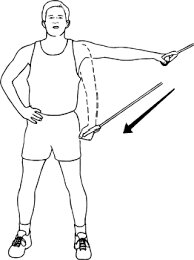
- This exercise involves using a cable machine to perform adduction of the arm.
- Stand sideways to the cable machine with your arm extended out to the side.
- Grasp the cable handle with your hand and pull it towards your body, keeping your elbow slightly bent.
- Return and repeat for 8-10 repetitions before switching sides.
Resistance band rows:
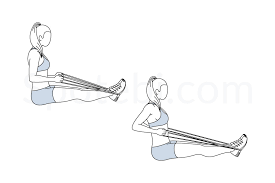
- This exercise involves using a resistance band to perform a rowing motion.
- Sit on the floor with your legs extended in front of you and the resistance band looped around your feet.
- Grasp the ends of the resistance band with your hands and pull them towards your chest, squeezing your shoulder blades together.
- Return to the starting position and repeat for 8-10 repetitions.
Strengthening exercise of the coracobrachialis muscle
Here are some exercises that can help to strengthen the coracobrachialis muscle:
Bicep curls:
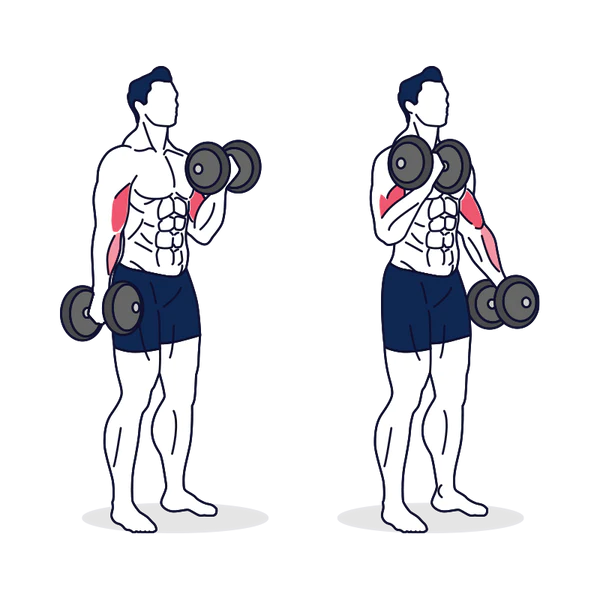
- While the bicep curl primarily targets the biceps brachii muscle, it also works the coracobrachialis.
- you can stand with feet shoulder-width apart and grasp a dumbbell in each hand with palms facing forward.
- Curl the weights up towards your shoulders while keeping your elbows close to your body, then slowly lower the weights back down to the starting position.
Cable pushdowns:
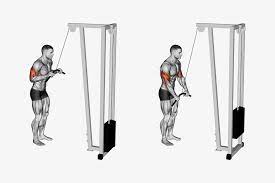
- Stand facing a cable machine with a rope attachment at the top.
- Grasp the rope with both hands and keep your elbows close to your sides.
- Push the rope down towards your thighs while keeping your elbows stationary, then slowly release back to the starting position.
Single-arm cable rows:
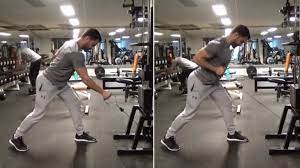
- Stand with your right side facing the cable machine, grasp the handle with your right hand, and take a few steps away from the machine.
- Lean forward slightly and keep your back straight. Pull the handle towards your midsection, then slowly release it back to the starting position.
- Repeat on the other side.
Standing dumbbell lateral raises:
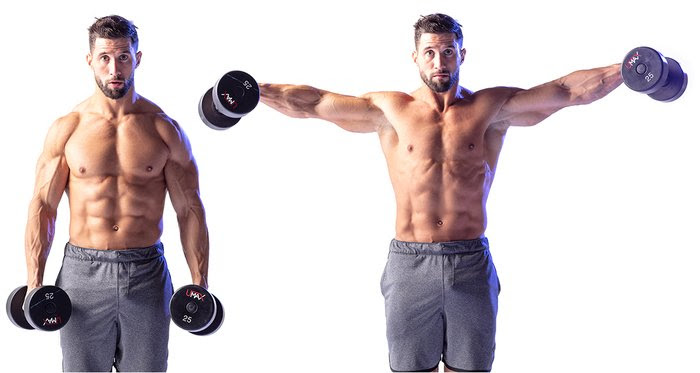
- Stand with your feet shoulder-width apart, hold a dumbbell in each hand, and keep your arms straight at your sides.
- Raise your arms out to the sides, keeping them parallel to the floor, then slowly lower them back down to the starting position.
Remember to always consult with a healthcare professional or certified fitness trainer before starting any exercise program, especially if you have any pre-existing medical conditions or injuries.
FAQ
Symptoms of an injured coracobrachialis muscle may include pain, tenderness, and weakness in the upper arm or shoulder. In severe cases, there may be swelling, bruising, or difficulty moving the arm.
A healthcare professional may diagnose a coracobrachialis injury based on a physical exam, imaging tests (such as an MRI or ultrasound), and a review of symptoms and medical history.
Maintaining good posture, using the proper technique during physical activity, and stretching before and after exercise can help to prevent coracobrachialis injuries. Strengthening the muscles of the shoulder and arm can also help to improve stability and reduce the risk of injury.
Yes, you can stretch the coracobrachialis muscle. To stretch this muscle, stand with your feet shoulder-width apart and raise the arm on the side you want to stretch straight out to the side at shoulder level. Bend your elbow and place your hand on your opposite shoulder. Use your other hand to gently pull your elbow towards your opposite shoulder until you feel a stretch in your upper arm. Hold the stretch for 15-30 seconds and then release. Repeat on the other side.
Yes, the coracobrachialis muscle is important for athletes and sports performance, particularly for movements that involve throwing or swinging, such as in baseball or golf. Strengthening and conditioning this muscle can help to improve arm speed, power, and accuracy.

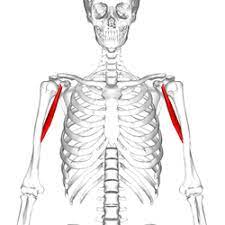
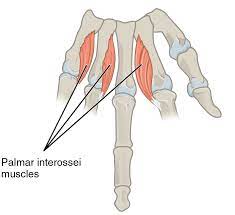
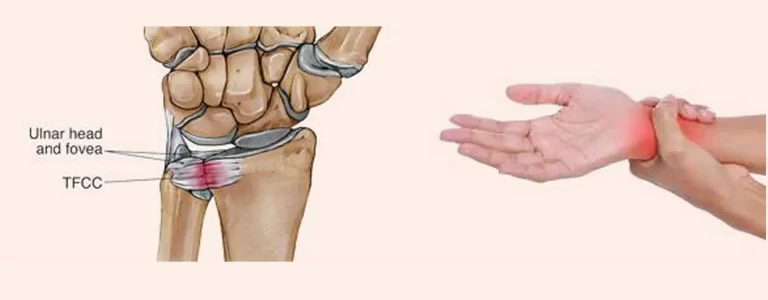
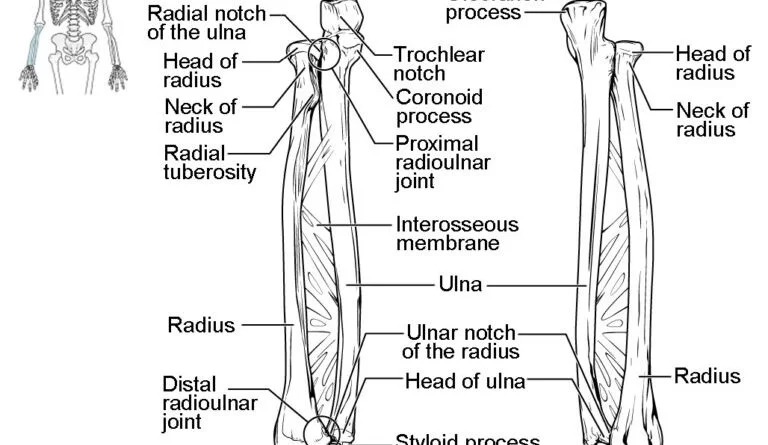
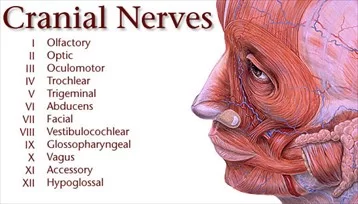
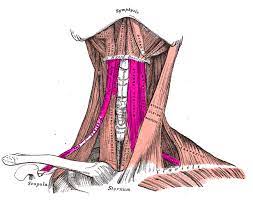
2 Comments